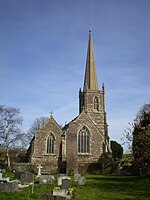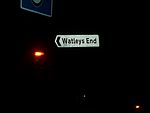Winterbourne is a large village in South Gloucestershire, England, situated just beyond the north fringe of Bristol. The village had a population of 8,965 according to the 2011 census. This has risen to 10,250 at the 2021 Census. The Civil Parish of Winterbourne is centred on the village and includes the neighbouring communities of Winterbourne Down, Hambrook and Frenchay. To the north-east is the village of Frampton Cotterell and to the west lies the new town of Bradley Stoke.
Winterbourne was recorded in the Domesday Book as Wintreborne, meaning 'Winter Stream'. The village is believed to have derived its name from the nearby Bradley Brook as much of medieval Winterbourne was originally built up around St Michael's Church, which is situated near the river.
The modern village is largely built on top of a hill, with woodlands and fields encompassing its urban features. The River Frome flows through a valley between the village and nearby Frampton Cotterell, continuing on towards Frenchay, and eventually draining via Mylne's Culvert, into the tidal Bristol Avon New Cut, to the east of what is now Gaol Ferry Bridge. The Bradley Brook divides Winterbourne from Bradley Stoke and Stoke Gifford to the west, before flowing into the Frome at Hambrook. Since the 1960s, the M4 motorway has bypassed the village to the southwest.
The Huckford Viaduct carries the Great Western Railway over the River Frome. Beneath the viaduct is the abandoned Huckford Quarry, a public nature reserve. Winterbourne is known for its large duck pond, which overlooks the Frome Valley and is a common spot for fishing and feeding the ducks and swans.The parish church is St Michael's, a building dating from the 12th century, which celebrated its 800th anniversary in 1998. St Michael's sits amid fields, flanked by cottages, with its prominent spire visible for miles around. At the altar is a stone depiction of the Last Supper, based on the painting by Leonardo da Vinci. Winterbourne Court Farm Barn is immediately adjacent to the church. This is a grade II* listed 14th century tithe barn and is an outstanding example of its type.Winterbourne has a number of pubs including the George and Dragon, the Swan and the Mason's Arms. In recent years, a number of the village's pubs have become restaurants; two of which now serve Indian cuisine. The village has three social hubs: St Michael's Rooms, Fromeside Community Centre and Greenfield, which host clubs, functions and other public events.
Winterbourne contains branches of the Co-op and Tesco Express, a chemist, optician, a handful of dental practices and a library. Other village amenities include a bakery, butcher and a Post Office serving the community. Horses and cattle are a common sight in the fields, including in the Cloisters area, which has views of the Frome Valley and the Huckford Viaduct.
As well as being the centre of a large civil parish, Winterbourne contains the hamlet of Watley's End, located on the border between Winterbourne and Frampton Cotterell. Nowadays, it is regarded as an area of Winterbourne, but a few decades ago it was considered to be a village in its own right. Some people in Watley's End continue to refer to the busy, uphill part of the village as 'Winterbourne Hill'. Salem, the local Methodist church, is in Watley's End.








